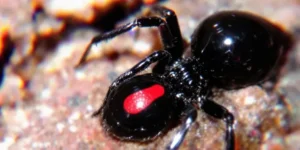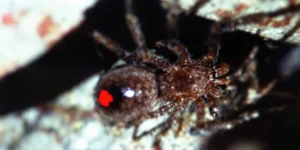Are you concerned about redback spider Australia? These small creatures can deliver a painful bite. The redback spider Australia is present throughout the country, in both urban and rural areas alike, making it important to stay alert and informed about their presence.
This blog will inform you on how to identify them and the steps to take if bitten. Continue reading to protect yourself from these Australian arachnids!
Key Takeaways
- Redback spiders live all over Australia in cities and the bush. They like dry spots and can go without food for 300 days.
- Female redbacks have a red stripe on their back and are more dangerous than males. Their venom can cause severe pain and other health issues.
- Bites often happen on hands, feet, arms, and legs. Symptoms include pain, sweating, nausea, and headaches. About 2,000 to 10,000 Aussies get bitten each year.
- Most people recover within a week. Only 250 cases need antivenom yearly. Deaths are now very rare thanks to modern treatment.
- To stay safe, keep shoes in boxes, clean outdoor areas, wear gloves in the garden, and teach kids about redbacks. If bitten, apply ice and see a doctor right away.

Overview of the Redback Spider Australia

Redback spiders are dangerous arachnids found in Australia. They’re part of the black widow family and have a venomous bite. Female redbacks are the main concern. They’re larger than males and have a distinctive red stripe on their back, which is the source of their name.
These spiders are small but resilient. Females can survive up to three years, while males typically live about six months. The females can store sperm for extended periods, enabling them to produce numerous offspring.
Now, we’ll examine the preferred habitats of these spiders in Australia.
Distribution and Habitat
Moving from the redback spider’s basic traits, we’ll explore where these arachnids live. Redback spiders originate in Australia, but they’ve expanded their range significantly. They now inhabit many parts of the world, largely due to human activity.
In Australia, redbacks flourish in urban and rural areas. They’re found in Brisbane, Perth, and Alice Springs. They prefer dry environments like forests and deserts. They also adapt well to human-populated areas.
Sheds, gardens, and backyards are their preferred locations. These resilient spiders can survive in extreme temperatures. They can endure without food for up to 300 days! Redbacks have also established populations in other countries.
They’ve been present in New Zealand since the 1980s. They arrived in the UAE in 1990. Japan has populations too, primarily in Osaka and Fukuoka. International shipping and trade have facilitated their global spread.
Male redbacks have limited mobility, though. They typically travel only about 3 metres in 6-8 weeks during mating season.
Venom and Its Effects
Moving from where redback spiders live, let’s examine their venom. Redback spiders use their fangs to inject venom into prey. This venom has a potent effect. It immobilises prey. Female redbacks also use a sticky substance to hold prey in place.
The venom contains a component called alpha-latrotoxin. This causes nerves to release excessive signals. It results in severe pain and other physiological issues. The female spider’s venom is highly potent.
A minuscule amount (0.08-0.10 mg) can cause harm. Tests on mice demonstrate its lethality. Prior to the development of an antidote, approximately 14 people may have died from bites.
However, there’s uncertainty whether the spider bites were the direct cause of all these deaths. Research in 2014 investigated the efficacy of the antidote compared to a placebo. Our understanding of redback spider venom continues to evolve.
Symptoms of a Bite
After a redback spider’s venom enters the body, it causes a range of symptoms. These symptoms, known as latrodectism, can vary in intensity and duration.
- Pain at the bite site starts within minutes and can last for days
- Sweating occurs, often in patches near the bite area
- Nausea and vomiting are common reactions to the venom
- Headaches range from mild to severe and may persist
- Agitation and restlessness are frequent symptoms
- High blood pressure (hypertension) can develop quickly
- Hands and feet are bitten in 46% of cases
- Upper arms and thighs account for 25% of bites
- The torso is affected in 21% of bite incidents
- Head and neck bites make up 7% of cases
- Most bites happen from December to April
- Afternoons and evenings see more bite occurrences
- Disturbing webs in shoes, clothes, or garden tools often leads to bites
- An estimated 2,000 to 10,000 Australians get bitten yearly
- About 250 cases need antivenom treatment annually
- Children and the elderly face higher risks from bites
- People with health issues may have worse reactions
- Most symptoms clear up within a week of the bite
Treatment and Prognosis
Redback spider bites require prompt attention. Initial first aid involves applying ice packs to alleviate discomfort. Avoid using pressure bandages or tourniquets. Seek medical assistance promptly and attempt to safely capture the spider.
In severe cases, medical professionals may administer antivenom. This specialised treatment is derived from horse blood and counteracts the spider’s venom.
The majority of bite victims recover within a week. Fatalities are now extremely uncommon. Only 2-20% of individuals bitten require antivenom. Medical professionals administer it as an injection or intravenously for severe cases.
Some recent research suggests antivenom may not be more effective than placebo treatments. Nonetheless, it’s advisable to consult a doctor if bitten by a redback spider. They can assist in managing your symptoms and ensuring your safety.
Supplementary Details
Our additional information is comprehensive! We’ve included fact-checking, safety advice, and images of bites. Continue reading for complete details about redback spiders.
Common Myths vs. Facts (Comparison Table)
Redback spiders are often misunderstood. Here are some common myths and facts to clarify misconceptions.
| Myth | Fact |
|---|---|
| Redback spiders are aggressive | They’re not aggressive. Bites are usually defensive |
| All redback bites are fatal | Fatalities are rare with modern treatment |
| Only adults are affected by bites | Children, the elderly, and those with health issues are more at risk |
| Antivenom is a new treatment | Antivenom has been used since 1956, greatly reducing deaths |
These facts demonstrate that while redback spiders can be dangerous, they’re not as deadly as many think. Understanding the truth can help people stay safe without excessive fear. For more information on Australian spiders, visit RedbackSpider.com.
Preventive Measures
Staying safe from redback spiders is essential. Here are some steps you can take to protect yourself and your family:
- Keep shoes and clothes in closed boxes. This prevents spiders from hiding in them.
- Clean sheds and outdoor chairs regularly. Redbacks prefer to live in these areas.
- Wear gloves when working in the garden. This protects your hands from spider bites.
- Educate children about redbacks and how to avoid them. Information helps keep everyone safe.
- Store garden tools in sealed containers. This keeps spiders out of your work gear.
- Check dark corners in your home often. Redbacks prefer quiet, dark places.
- Use pest control services if necessary. They can help remove spiders safely.
- Seal cracks in walls and floors. This prevents spiders from entering.
- Keep your yard tidy and free of clutter. This reduces hiding places for redbacks.
- Shake out clothes and towels before use. This removes any hiding spiders.
Now, we’ll examine the symptoms you might experience if a redback spider bites you.
Visuals of Redback Spider Australia Bites
Redback spider bites can appear alarming. Images assist in illustrating their appearance. Initially, a small red spot may be visible. This spot can expand and become swollen. The surrounding skin may turn bright red.
In severe cases, the bite area can become significantly enlarged and puffy. Images can demonstrate how the bite changes over time. They also assist people in recognising what to monitor after a bite.
Viewing images of bites aids doctors as well. They can compare what they observe to known cases. This assists them in providing appropriate care promptly. Some images show how bites heal with treatment.
These are valuable for educational purposes. However, if you suspect you’ve been bitten, don’t delay. Seek medical attention immediately. Redback spider bites can cause significant pain and other complications if not treated promptly.
Redback Spider in Australia: Are Spiders Really a Pest Control Concern?
RedBackSpider.com presents a close look at the redback spider. This post matters because spiders really affect safety, and understanding pest control steps can make a difference.
1. Redback Bite
A redback bite may cause severe symptoms. If bitten by a redback spider, observe the bite without delay for swelling around the limb.
2. Web
The redback’s web often appears near shelter such as a garage. Egg sac clusters can form, containing multiple eggs the size of a large pea.
3. Bitten by a Redback Spider
When bitten by redback spiders, redback venom spreads slowly. Female redback individuals typically cause more trouble than male redback spiders.
4. Survive a Redback Bite
To survive a redback bite, it’s important to seek immediate help. Redback spiders tend to lurk in sheds and garages, so watch for their striped abdomen.
5. Female Redback
A female redback can show a stripe on the upper abdomen. Their light brown with white markings juveniles also exist. Absence of a red dorsal pattern is possible in some phases.
6. Australian
Australia is home to the australian redback spider, a relative of the redback spider akin to a black widow. Found throughout australia, they might also inhabit north and south america or pacific islands.
7. Antivenom
Antivenom is available, offering supportive care to manage venom if needed. Use of an ice or a cold pack on the bite site helps reduce pain.
8. Black Widow
A black widow spider is a widow spiders variant. The red dorsal stripe indicates a venom acts directly pattern.
9. Professional Pest
For ongoing control, professional pest services can help reduce multiple redback bites risk and keep children safe.
Comparison Table: Redback Spider Facts
| Feature | Details |
|---|---|
| Typical Abdomen Color | Light brown with white markings |
| Average Size (mm) | 10–14 mm (female) |
| Common Habitat | Garage, sheds, hidden areas |
| Envenomation Severity | Potentially harmful to humans |
Key Points to Remember: about Redback Spider Australia
- A red back can cause various symptoms via redback venom.
- Female redback spiders are especially potent.
- Apply ice or a cold compress to help.
- Seek veterinary attention immediately if a dog has been bitten.
- Best to seek aid for suspected bites, preventing any worsen the pain scenario.
Conclusion
Redback spiders are a part of Aussie life. We need to stay alert and know how to stay safe. Learning about these spiders helps us avoid bites. If a bite occurs, quick action is essential.
With care and knowledge, we can coexist with these unique creatures.
For a closer look at what Redback Spider bites look like, check out our gallery of photos here.
FAQs
1. What’s the deal with redback spiders Australia?
Redbacks, or Latrodectus hasselti, are common Aussie arachnids… They’re known for their black bodies and red stripe. These little critters love hiding in dark spots around homes and gardens.
2. How bad is a redback spider bite?
A bite from these buggers can be nasty, mates. It causes pain, sweating, and nausea… In rare cases, it might lead to more serious issues. But don’t worry too much – no one’s died from a redback bite since 1956.
3. What should I do if a Redback Spider Australia bites me?
First up, stay calm. Apply a cold pack to the bite area, and get to a hospital quick smart. The docs might give you antivenom if needed. Remember, better safe than sorry when it comes to these little biters.
4. How can I keep redbacks away from my place?
To avoid these eight-legged visitors, keep your yard tidy. Clear out junk and seal up cracks in walls. Shake out your shoes before wearing them, especially if they’ve been outside. A bit of care goes a long way in keeping these spiders at bay.





